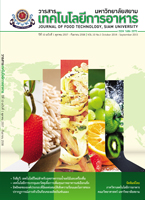Compositional Effect on Thermal Properties and Opportunities of Milk Powder Stickiness Phenomena
Main Article Content
Abstract
Stickiness in the production of food powders can cause low yield, operational problems of equipment, powder-handling problems and fire hazards. It may result from the appearance of attractive forces between particles including static electricity. Stickiness in food systems often appears when the surface viscosity of amorphous particle components decreases and particles adhere. Increasing adhesion forces between particles causing stickiness and caking depends on the material properties, storage and processing conditions. Stickiness is a serious problem in spray drying of sugar-rich and fat-rich products, such as milk and juice. Solids composition affects structure formation and changes of foods during processing and storage. Powders containing high sugar contents show high adhesion of powder particles with increasing temperatures and water contents as a result of surface plasticization and the formation of liquid bridges. The stickiness of milk powders resulted from liquid flow of amorphous non-fat solids components, such as lactose and other hydrophilic components. They are plasticized by water, which is one of the dominant factors that control glass transition of amorphous solids. Glass transition is relation to stickiness and the SPT at 20 °C above the Tg. Increasing molecular mobility of molecules occurs above glass transition with concomitant appearance of viscous liquid-like characteristics, which are relative to the development of stickiness in amorphous particles. Although several researchers have indicated the relationships of stickiness and glass transition, the relaxation times and molecular mobility still remain as challenging areas in the glass transition research. Increased molecular mobility is related to decreased relaxation times and a lower viscosity above the glass transition. Changes in solid structure around the glass transition of amorphous systems can be measured from molecular motions using various techniques, such as dielectric analysis (DEA) and dynamic-mechanical analysis (DMA). The primary α-relaxation appears in measurements of dielectric and mechanical properties since the molecules gain translational mobility and long-range molecular motions around the glass transition. However, the stickiness behavior and molecular mobility of milk solids systems with different solids compositions (carbohydrate-carbohydrate and carbohydrate-protein) has not been either well addressed. Therefore, the present review emphasized the solids compositional effect on relaxations and molecular mobility around the glass transition in relation to stickiness behavior.
Article Details
Copyrights of all articles in the Journal of Food Technology available in print or online are owned by Siam University and protected by law.


